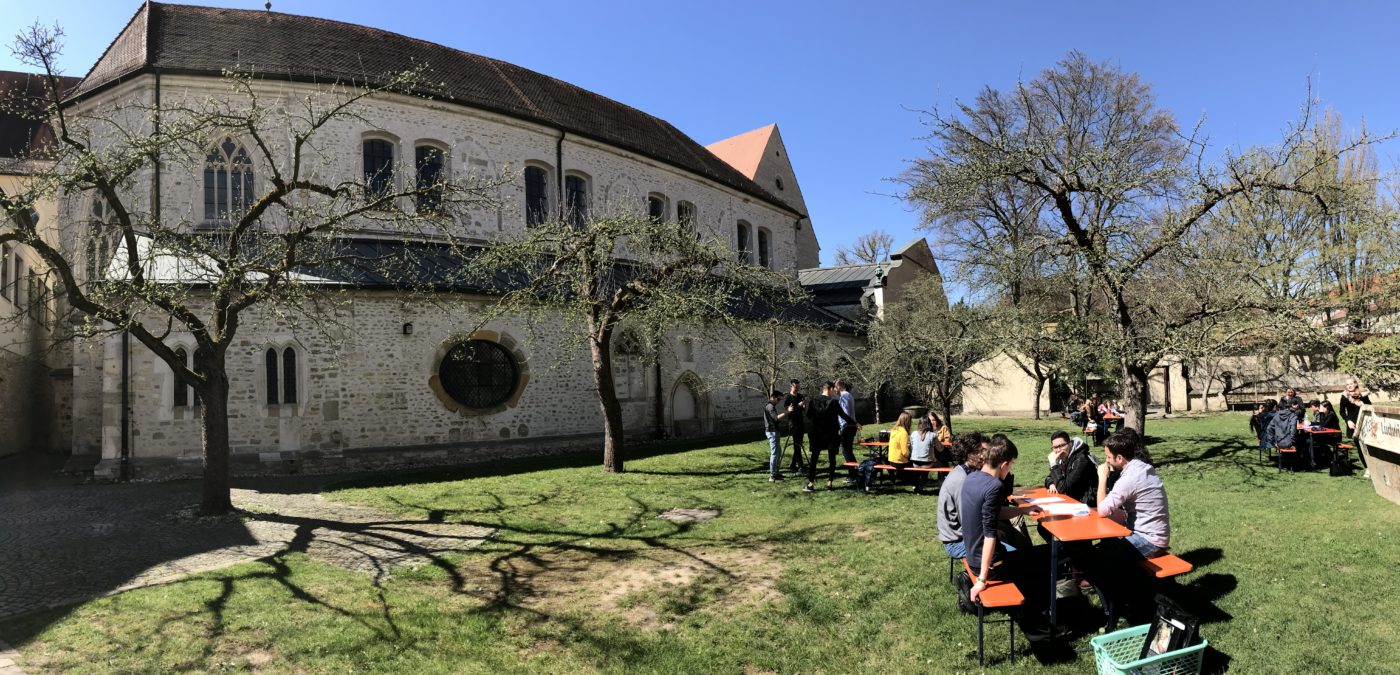18 July 2018
European Year of Cultural Heritage 2018 – Lost Traces in Regensburg – St. Emmeram
Regensburg, Germany

A European School Project takes Czech, Italy and German Students on a Search for [Architectural] Evidence in and around the Basilica St. Emmeram
In 2018 events are taking place across Europe as part of the European Cultural Heritage Year. Their collective aim is to shed light on Europe’s rich cultural heritage. The UNESCO World Heritage Coordination, part of the City of Regensburg’s Department of Culture, is also extending an invitation to take part in the event, “Sharing Heritage,” in which citizens can experience and share their own cultural backgrounds. In cooperation with the City of Regensburg, the architects, Stephanie Reiterer and Jan Weber-Ebnet, initiated a school project for the charitable Association, Architecture and Training (registered association). Called LOST TRACES, it sends young people on a search for architectural evidence.
Within the framework of this project, students from the German School Prag, Liceo Scientifico “P.S. Mancini“ in Avellino, and Lappersdorf High School accordingly set out in search of [architectural] evidence at the former Imperial Abbey of St. Emmeram from April 12th to 15th. The church complex is a fascinating place of cultural heritage from which Europe’s history and culture can be discerned. Renowned in Regensburg, the religious space of St. Emmeram offers the average visitor exceptional access to the cityscape and many of its hidden places. The project’s aim was to draw greater attention to St. Emmeram as a cultural site, and over a short period of time create greater public awareness.
Under the coordination of Ms. Reindlmeier, Mr. Weissgerber, and Mr. Kufner various workshops took place. These brought the site even closer to the public in respect to history, architecture, film, and photography. Active support was given to Ms. Grüninger-Schmitz’s student teams, as well as Stephanie Reiterer’s and Jan Weber-Ebnet’s project team.
After their Friday and Saturday preparations the students invited visitors to a Sunday church service. Together, with the church congregation, they publicly presented the outcomes of the workshops.
Following the welcoming address by Mr. Klemens Unger, Cultural Adviser, in which kind regards were extended from Mayor Gertrud Maltz-Schwarzfisher, his Holiness Roman Gerl, City Deacon, also expressed his pleasure with the youth engagement. It was very important to him that the parish, St. Emmeram, continue to be open to the city and that the public space become a closer part of the church. Structurally, many changes are planned for the site in the coming years; changes to the building design will facilitate greater interaction between the congregation and the public. The Deacon was also more than pleased to participate in Regensburg’s inner-city projects with interested students in the future.
Following a brief project presentation by the teacher’s team from Lappersdorf, the students attended to the hosting and facilitation of the guest program. The first point of focus was the history of the former cloister, whose changing fortunes were reviewed by a theatre group. Attendees were especially impressed by periodically interspersed references to the present, such as when the duke’s daughter, Uta, was shown to be a follower of the ‘#metoo’ movement. After the program attendees could view the findings from the architectural search for evidence. It was here that the students created a bridge from Emmeramsplatz to the cloister garden by constructing urban green oases on several parking spaces, as well as directional signs into the area of the church. In this way students could acquire a cross-section of interviews in which pedestrians in Regensburg would be queried about their knowledge of St. Emmeram. What is more, opinions were aired concerning Europe, German-Czech and German-Italian relations, often to the amusement of on-lookers.
Finally, under sunny skies, an exhibit in the orchard by the photography group concluded the event. An international student band provided accompaniment to the setting while guests were led through a presentation of findings.
Participants and guests were most impressed by the efforts and achievements of the students who worked on the project. The students’ pleasure in designing and promoting the project was apparent. As such, a European ideal became appreciable in the way individual, multi-national school teams worked hand in hand.
The project, LOST TRACES, will continue to be thematic for students. In June, a reciprocal visit will be made to Prag, where students will help the public rediscover “Collbenka 1704.” And at the end of September they will become patrons of the church, Chiesa di Monserrato in Avellino. For those interested, the students also created a blog in which project developments are presented to the public. The various activities can be looked up under echy.gymlap.de .
A sincere thank you went out not only to the participants but also to the European Union for its financial support of like-projects through the “Erasmus+” educational program.


